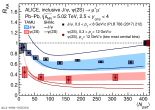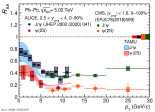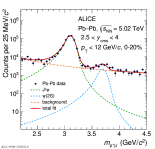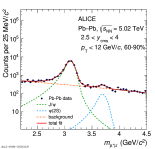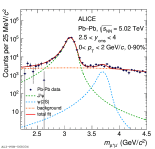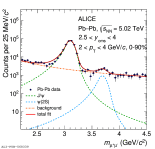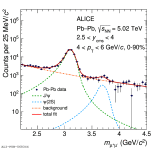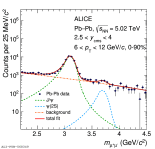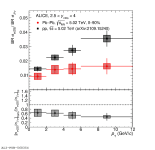Figures from paper submitted to Physical Review Letters
Abstract:
The production of the $\psi(2S)$ charmonium state was measured with ALICE in Pb-Pb collisions at $\sqrt{s_{\rm NN}}=5.02$ TeV, in the dimuon decay channel. A significant signal was observed for the first time at LHC energies down to zero transverse momentum, at forward rapidity ($2.5<~y<~4$). The measurement of the ratio of the inclusive production cross sections of the $\psi(2S)$ and J/$\psi$ resonances is reported as a function of the centrality of the collisions and of transverse momentum, in the region $p_{\rm T}<~12$ GeV/$c$. The results are compared with the corresponding measurements in pp collisions, by forming the double ratio $[\sigma^{\psi(2S)}/\sigma^{J/\psi}]_{\rm{Pb-Pb}}/[\sigma^{\psi(2S)}/\sigma^{J/\psi}]_{\rm{pp}}$. It is found that in Pb-Pb collisions the $\psi(2S)$ is suppressed by a factor of $\sim 2$ with respect to the J/$\psi$. The $\psi(2S)$ nuclear modification factor $R_{\rm AA}$ was also obtained as a function of both centrality and $p_{\rm T}$. The results show that the $\psi(2S)$ resonance yield is strongly suppressed in Pb-Pb collisions, by a factor up to $\sim 3$ with respect to pp. Comparisons of cross section ratios with previous SPS findings by the NA50 experiment and of $R_{\rm AA}$ with higher-$p_{\rm T}$ results at LHC energy are also reported. These results and the corresponding comparisons with calculations of transport and statistical models address questions on the presence and properties of charmonium states in the quark-gluon plasma formed in nuclear collisions at the LHC.
Phys. Rev. Lett. 132 (2024) 042301
e-Print: arXiv:2210.08893 | PDF | inSPIRE


